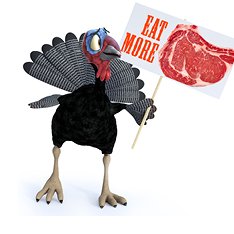Gobble gobble gobble: Turn that
turkey stumble into a turkey strut
Greetings *|FNAME|*,
 One week from today, many of us will enjoy precious time with loved ones during Thanksgiving. The rituals of familiar seasonal foods and comfortable family traditions rejuvenate my spirit, bringing a calmness and contentment after such a demanding year. Although I am not a member of team turkey, I do enjoy a good holiday honey ham from time to time. However, with so much travel back and forth from Houston this year, Paul and I thought it fitting to each enjoy a Texas-sized rib eye as our centerpiece. Thankfully we have that choice, because not everyone can choose what they are eating for Thanksgiving or the company they have while sharing the meal.
One week from today, many of us will enjoy precious time with loved ones during Thanksgiving. The rituals of familiar seasonal foods and comfortable family traditions rejuvenate my spirit, bringing a calmness and contentment after such a demanding year. Although I am not a member of team turkey, I do enjoy a good holiday honey ham from time to time. However, with so much travel back and forth from Houston this year, Paul and I thought it fitting to each enjoy a Texas-sized rib eye as our centerpiece. Thankfully we have that choice, because not everyone can choose what they are eating for Thanksgiving or the company they have while sharing the meal.
Likewise, no one can choose the parents to whom they are born. While many of us grew up with healthy, fairly normal and loving parents, a surprising number of us did not. For those of us in households where alcoholism, drug addiction, mental illness, or financial hardship have taken hold, there is often a desperate grasping for anything that is more stable to deal with family chaos. We stumble a lot along the way because these chaotic conditions create a long-lasting, radical variability in a family, driving a broad, painful wedge between its members. This variability stokes anxiety, and the perceived lack of control perpetuates fear. The fear, in turn, builds distrust and isolation. And all along the way, our coping mechanisms become badly skewed, negatively impacting us at home, in school and around the workplace.
Employees who were raised as children in such an emotionally bleak wilderness can interpret current innocuous events as threatening. Each day, these workers feel like they are unsteadily heading for the chopping block. Expressing gratitude? Holding optimism for the future? Neither feels practical at all. So what can we do when chaos seems to reign?
Renowned Stanford psychologist Dr. Albert Bandura stated that developing and applying coping skills is the one skill group that crosses into all others, enabling individuals to create greater stability in chaotic situations. Emad B. Algorani and Vikas Gupta categorize coping skills as:
- Problem-focused, which addresses the problem causing the distress: Examples of this style include active coping, planning, restraint coping, and suppression of competing activities.
- Emotion-focused, which aims to reduce the negative emotions associated with the problem: Examples of this style include positive reframing, acceptance, turning to religion, and humor.
- Meaning-focused, in which an individual uses cognitive strategies to derive and manage the meaning of the situation
- Social coping (support-seeking) in which an individual reduces stress by seeking emotional or instrumental support from their community.
But why create a workplace environment that strengthens coping skills in colleagues and subordinates? Shouldn't they just do that on their own? An increase in employee coping skills actually helps mitigate chaos more broadly, reducing risk and strengthening capacity of your organization, especially for when it does face a business crisis. See how strong your own coping skill capabilities are by trying out this coping self-efficacy scale. Then consider how you can champion these three principles in the workplace.
Coping Skill #1: Calibrate Your Control

Identify what you can change immediately, then build on that. Progress begins inside us first, then goes up to the surface, then follows out to within arm's reach, and finally extends as far as our influence goes. But avoid the trap of focusing on what we CAN'T change, because those challenges will keep growing bigger and farther out of our control. By focusing on the areas where we can actually make a difference, we cultivate a safety zone that allows our "turkey tail feathers" to spread wider and extend positive impact.
Coping Skill #2: Recognize The Patterns

As the animation on the right portrays, in seemingly chaotic situations, there are observable patterns that eventually emerge. Remain watchful during a crisis to gauge its effects. Afterwards, build a thorough understanding of those effects so you can work your way backwards and identify the thresholds and amplitude of different contributors. Over time, the borders and boundaries of the system will become perfectly clear, providing critical insight to implement lasting change. The path will also feel firmer with each step forward, so teams feel safe to strut their stuff.
Coping Skill #3: Embrace Infinity

We humans are social creatures who carefully navigate the structures of belonging or exclusion to make sense of our place in the world. We leverage the collective capacity of culture, community, business, and other institutions to make safe places for ourselves and those we love. But beneath that logic of our affiliations is a deeper need for a healthy connection to something greater. It is grounded in things we can't readily observe or even comprehend, which might seem the antithesis of an evidence-based rationale. It's not. Instead, it is a confident humility, and a release of ego, that places trust in a restorative higher power. One that is truly in your corner. So regardless of what your beliefs may be, consider placing more trust in that which has no beginning or end. Then observe what positive change the trust in something benevolent produces in you and even your staff over the long term.
Sometimes there is some heated conversation during Thanksgiving dinner about things we don't all agree on. That's only natural. But if we strengthen coping skills and talk turkey with our valued "guests around our table" who face their own challenges, we can help reduce chaos so that everyone makes it through each crisis intact. In fact, we will have even stronger ties to one another.
Faithfully,


Sue
Email | LinkedIn | V-Card